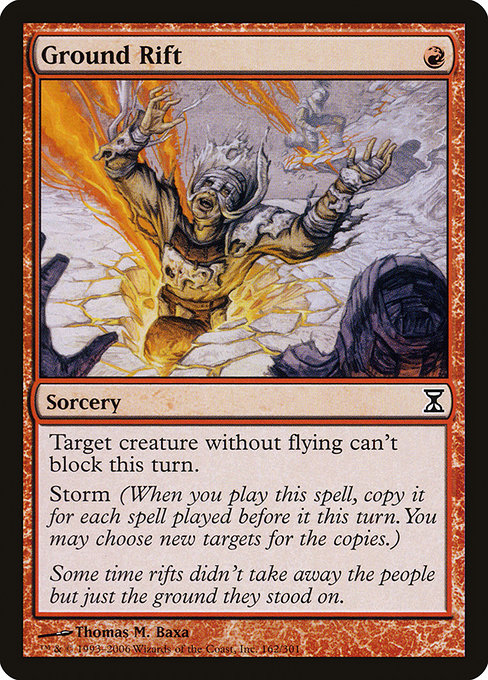
Image courtesy of Scryfall.com
Evolution of Ground Rift’s Mechanics Across Time
Ground Rift is a microcosm of how MTG’s mechanical language has evolved over the years. A single red mana opens a pair of dramatic ideas: a targeted disruption on the battlefield and a Storm-driven payoff that scales with the speed of your spell stack. When Time Spiral printed this card in 2006, it arrived as a compact lesson in tempo, risk, and the playful chaos that Storm can unleash. The card’s text—“Target creature without flying can't block this turn. Storm (When you cast this spell, copy it for each spell cast before it this turn. You may choose new targets for the copies.)”—reads like a design diary: a simple cost, a clear constraint, and a dramatic payoff that depends on what happened earlier in the turn. 🧙♂️🔥
Storm is a centerpiece of Ground Rift’s identity. It invites you to think in reverse: you don’t just cast Ground Rift once; you sculpt a moment where every spell cast before it amplifies your effect. In practice, that means a disciplined sequencing discipline: lay down cheap cantrips or acceleration to build your storm count, then reveal Ground Rift as the capstone that can swing combat in a heartbeat. The practical payoff is a dramatic swing, even from a modest mana investment. This is red tempo at its theatrical best—assault the board, surprise your opponent, and watch the stack do the heavy lifting. ⚔️
- Tempo with a twist: A single red mana buys a moment where the defending creature loses its blocking potential, enabling clean damage through a narrowed defense and a possible race to the finish.
- Storm’s narrative payoff: The more spells you cast before Ground Rift, the more copies you get. The thrill? You might mirror Ground Rift across multiple targets or simply flood the battlefield with repeated effects in a single turn.
- Blocking as a limitation: The “cannot block” clause gives the attacking player a controlled aggression—Ground Rift isn’t a surprise win so much as a carefully choreographed ambush.
- Restricted by red’s toolkit: This aligns with red’s agenda: speed, risk, and flash-fire moments rather than long, ponderous ramps. The card embodies red’s love of tempo plays and aggressive air-drops of damage. 🔥
A Closer Look: Textrue, Flavor, and Lore
The art by Thomas M. Baxa captures a world where time itself peels away at the ground, leaving an echo of the battlefield’s earlier life. The flavor text—“Some time rifts didn't take away the people but just the ground they stood on.”—reads like a quiet note from the Time Spiral era, where the very landscape becomes a puzzle box for the player who dares to manipulate it. The combination of a classic red frame, bold Storm keyword, and a commonslot rarity makes Ground Rift a storytelling piece as much as a playable one. 🎨
Ground Rift isn't just about making a creature unable to block; it's about the moment you realize your dozen-year-old spells can interact with the present in startling ways.
From a design perspective, Ground Rift showcases how a simple effect can carry forward into new contexts. Time Spiral’s narrative world—where time itself is a mutable resource—encouraged designers to reprint and repurpose mechanics with a fresh coat of flavor. The storm mechanic’s evergreen appeal lies in its potential for arcane math: every cast before Ground Rift adds a copy, but every copy costs you something in the storm-count economy—it’s a mental puzzle as much as a battlefield tactic. 🧩
Design Evolution: Storm, Red Decks, and Modern Formats
Ground Rift sits at an interesting crossroad: a storm-enabled tempo spell that remains playable in Modern and legacy formats, yet rooted in an era when time-shifted magic and tricky mana curves ruled the roost. As MTG evolved, storm-inspired cards found themselves reinterpreted through new design lenses—think of how modern red composite spells, mana peaks, and combo-interaction safety nets shape today’s environments. Ground Rift’s mechanic arc—from a straightforward punisher on blocking to a catalyst for stacked spells—offers a clear throughline for players exploring how limited-pickle engines can become game-changing in the hands of a patient tactician. 💎
In practice, you’ll see Ground Rift used in decks that aim to maximize early pressure and mid-game inevitability. The card’s common rarity makes it approachable, while foil versions give collectors something to chase. Its value lies less in price than in the story it tells about that moment in MTG history when Storm and tempo collided on a red stage. The Time Spiral printing era also highlights how Wizards of the Coast loves to experiment with time-themed reimagining—Ground Rift is a micro-artifact of that era’s mood and playstyle. 🎲
Collectibility, Value, and Playability
Ground Rift has hovered in the accessible zone for players building budget-friendly red decks, with a foil showing off a touch of archival sheen for collectors. The card’s practical floor remains tied to a turn-one or early-turn sequence that can tilt a game, while its ceiling—tapping into the storm engine—offers dramatic finishes in the right lineup. For modern players, Ground Rift serves as a reminder that a single, well-timed spell can multiply into a swarm of threats, especially when your deck is designed to push through a resilient blocker or to force a swing that wins on the back of the turn’s math. ⚔️
As you explore Time Spiral-era cards, Ground Rift stands out for teaching that simplicity can be potent when paired with a well-timed pay-off. The presence of a red Storm spell in a common slot is a design left hook: you can draft or play it for tempo, then watch your stack perform as copies cascade across the battlefield. And yes, that Storm keyword remains a party trick—the kind of mechanic that makes MTG’s kitchen-table moments feel like a magical experiment. 🧙♂️
Phone Case with Card Holder MagSafe CompatibleMore from our network
- https://crypto-acolytes.xyz/blog/post/defi-trading-bots-explained-how-they-work-and-why-it-matters/
- https://crypto-acolytes.xyz/blog/post/parallax-maps-a-hot-blue-star-across-spiral-arms/
- https://blog.digital-vault.xyz/blog/post/storytelling-as-balance-for-unclaimed-territory-in-mtg/
- https://crypto-acolytes.xyz/blog/post/discover-alien-planets-in-open-world-games/
- https://blog.digital-vault.xyz/blog/post/unraveling-stonehoof-chieftains-minotaur-tribal-identity/